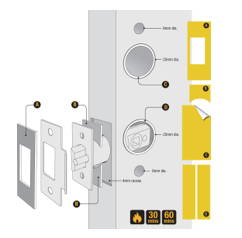Locks and Security News: your weekly locks and security industry newsletter
24th April 2024 Issue no. 702
Your industry news - first
We strongly recommend viewing Locks and Security News full size in your web browser. Click our masthead above to visit our website version.
Autumnal breaks in the UK mean fire safety is as critical as ever
 The Fire Door Inspection Scheme says that last year a staggering 75% of UK fire doors failed inspection, the majority of which are in rented buildings. Given the rapid increase in holiday cottage lets, and the number with real fires, it’s possible that some of these rentals don’t meet fire safety standards.
The Fire Door Inspection Scheme says that last year a staggering 75% of UK fire doors failed inspection, the majority of which are in rented buildings. Given the rapid increase in holiday cottage lets, and the number with real fires, it’s possible that some of these rentals don’t meet fire safety standards.
From the rugged coastline of Cornwall to the tumbling leaves of the New Forest and the heather clad Highlands, the UK is a wonderful place to take an autumnal break. Especially when you can spend a cosy evening in front of an open fire or wood burner. It’s no wonder that so called ‘staycations’ are still very much the order of the day for many UK holidaymakers.
To meet the demand, the number of UK holiday homes has risen by 40%. But the rapid increase has brought with it several concerns. Top amongst them is fire safety.
At least one holiday let landlord has been fined for breach of fire safety regulations. The owner of a self-catering premises in Perranporth, Cornwall, was ordered to pay nearly £4,000 in fines and costs after his premises failed to meet fire safety regulations. But a fine is not the worst that could happen, summing up the case the magistrate said, “Potentially people could have died. Luckily this did not occur.”
Whether you’re renting a holiday home, or renting one out, it’s important to know the safety requirements. From shepherd’s huts in Scotland, to cottages in Clovelly, here’s an overview of a landlord’s main fire safety duties:
Fire safety measures
Multi-purpose fire extinguishers, emergency lighting, a fire blanket and fire exit signage must be included within all holiday homes.
Fire detection and carbon monoxide detectors
At least one smoke alarm must be installed on every floor of a rented property. A carbon monoxide alarm must also be fitted to any room that contains a solid fuel burning appliance such as a coal fire or wood burning stove. Landlords must test alarms at the start of every tenancy.
As of February, all homes in Scotland must also have an interlinked fire alarm system. It’s the first of the UK nations to pass this legislation in the wake of the 2017 Grenfell Tower fire, and it means that if one alarm goes off, all alarms go off.
Electrical fire and gas safety
Landlords must also ensure that all electrical appliances, circuits, and fixed installations within the property are safe. Although not a legal requirement, landlords are also advised to obtain an Electrical Safety Certificate that provides proof that a qualified electrical engineer has inspected the premises. Insurance may be invalid if this inspection has not been carried out.
With regards to gas, properties that use gas supply for central heating or cooking appliances, must hold a valid Gas Safety Certificate. These appliances must be regularly maintained and serviced by a Gas Safe registered engineer.
Furniture safety
To comply with the Furniture and Furnishings (Fire Safety) Regulations 1988, landlords must ensure that all furniture is “fire resistant” by checking the manufacturers permanent label which signifies compliance.
Fire doors
Fire doors are worth singling out for attention as they are often neglected, and many UK fire doors fail inspection. They play a vital role in helping to stop the spread of heat and smoke, protecting lives as well as buildings, and are an essential requirement for flats, or houses with loft conversions. They are also recommended for the kitchens of all rented properties.
What more can you do?
Another way landlords can help to ensure maximum protection against a fire is to install fire rated locks with fire kits. FireKit by Codelocks fits to the lock of a door and adds additional protection by ensuring that smoke and fire cannot travel through lock installation gaps. Easy to install and compatible with new and existing Codelocks mechanical and electronic latch lock products, Codelocks’ FireKit provides locks with 30- or 60-minutes fire protection allowing tenants more time to safely evacuate. In the event of a fire, intumescent strips and tubes expand to protect the latch, filling any apertures to stop smoke escaping and flames spreading. Alternatively, you can replace an existing lock with a coded lock from Codelocks’ Fire Rated Lock range.
For more detailed information on your fire safety responsibilities refer to the government website
2nd November 2022








